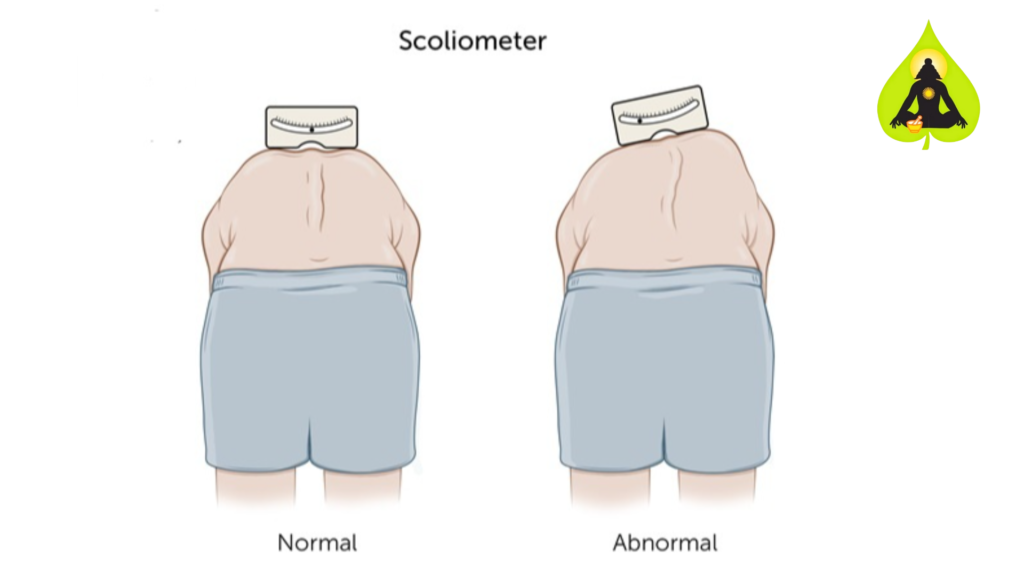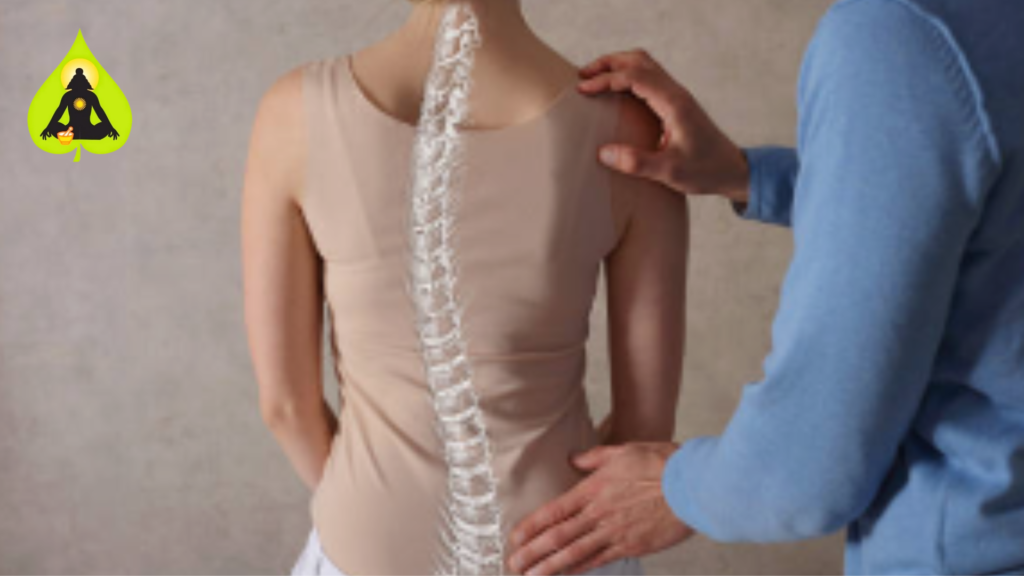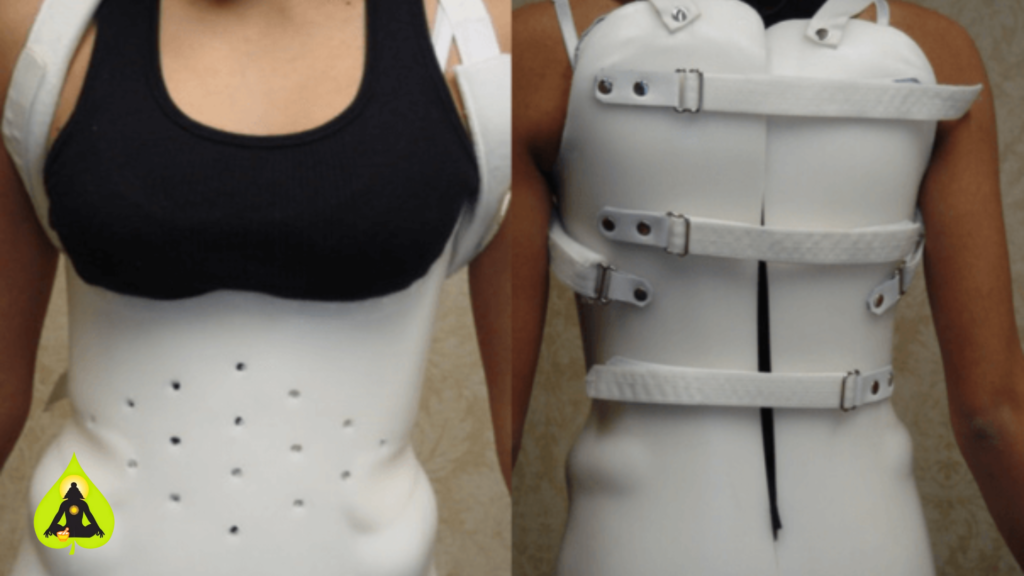Table of Contents
ToggleIntroduction:

Scoliosis is a condition which causes your spine to curve to one side. Person suffering from scoliosis will have a C- or S-shaped curving in the spine. The most common regions are at the range of the chest or the lower back, though it can befall anywhere in the spine. This condition is seen more to befall children. Though the condition can appear at any age, it is often recognized at the age of 9 to 15 years (Puberty), though symptoms can at times show at the infant age. It’s predominantly seen in female gender, & persons with family history.
There is no 100% cure for scoliosis, but the symptoms can be reduced. Generally treatments are not needed, if scoliosis (COBB Angle) is below 20 degrees & as the curve tends to correct itself with growth. But based on the degree of curvature and the age, a combination of diet, exercise and physical massage is often recommended.
Most cases of scoliosis are mild, but some children develop spine deformities that continue to get more severe as they grow. Severe scoliosis can be disabling. An especially severe spinal curve can reduce the amount of space within the chest, making it difficult for the lungs to function properly.
Dignostic Methods for Scoliosis:

Children who have mild scoliosis are monitored closely, usually with X-rays, to see if the curve is getting worse.
The complications arising from scoliosis can range from chronic pain to respiratory deficiencies. If the curve is structural then it is permanent, & may mostly be due to some other condition. But a non-structural curve will be temporary and is likely to disappear with time.
Diagnosis is done by the physical exam & by imaging techniques such as X-rays, CT scans, or MRI.
Test for Scoliosis:

The Adam’s forward bend test is a screening test for scoliosis. The test is most powerful for thoracic scoliosis.
The prognosis for an individual with scoliosis ranges from mainly good to fair, depending on how early the problem is diagnosed and treated.
Causes of Scoliosis:

Some of the possible causes of scoliosis are found as:
- Neuromuscular conditions like cerebral palsy, spina bifida & muscular dystrophy can affect the nerves and muscles. These can lead to scoliosis.
- Idiopathic adolescent scoliosis: cause is unknown.
- Congenital scoliosis: This is rare and occurs at birth because the bones of the spine developed abnormally during fetus growth inside the mother.
- Degenerative scoliosis: is also known as adult onset scoliosis which is caused by degeneration of the facet joints & intervertebral discs which are the moving parts of the spine. This degeneration & resulting spinal asymmetry can occur slowly over time as a person ages.
- Other causes can include a habitual bad posture, carrying loads or some injuries.
Symptoms of Scoliosis:

Symptoms of scoliosis normally become apparent from infancy to adolescence.
The symptoms include:
- The head may be found slightly off the center. A rotation of the neck causes the head to tilt in one direction.
- Prominence of the ribs on one side. The ribcage is found to be asymmetrical i.e. the ribs may be at varied heights.
- A hip is more protruded than the other.
- Your clothes are not hanging properly.
- The leg lengths will be uneven.
- Tilted, uneven shoulders, with one shoulder blade protruding more than the other.
- Uneven waistline.
- Overall appearance of leaning to the side.
- In rare cases, there may be a problem with the spinal cord or nerves that produces weakness, numbness or a loss of coordination.
In infants, if the case is severe, it can even lead to problems or complications of scoliosis which includes the heart and lungs issues, respiratory deficiencies like shortness of breath and gradually ending in chronic chest pain & decreased exercise capacity.
Exercises for Scoliosis:

Various exercises with different strategies are suggested for scoliosis. The main aim of exercises in this case is to realign your faulted proportion of spine, rib cage, shoulders or the pelvis to regain a normal posture.
Many yoga poses can be recommended for alignment of spine:
- Bhujangasan / Cobra posture.
- Chakrasan/ Wheel posture.
- Suryanamaskar (Sun salutation).
- Dhanurasan / Bow pose.
- Natarajasan / lord of dancing pose.
- Setubandhasan / Bridge pose.
- Adho-mukh-shwanasan / Downward facing dog posture.
- Shalabhasan / Locust pose.
- Kapalbhati pranayam.
Treatments of Scoliosis:

- Scoliosis, even though a disturbing condition, generally doesn’t demand treatment if it’s a mild curve (COBB angle less than 20 degree).
- Epidural injections for pain relief.
- Scoliosis brace: (COBB angle is in between 20-40 degree) Boston brace or any kind of scoliosis correction brace is needed to keep the spine in erect posture.
- If COBB angle is more than 40 degree then surgery is the only option which is needed.
Ayurvedic Treatments Options of Scoliosis:

Ayurved always opts for tangible alternatives to allopathic ways like surgery and other invasive procedures like epidural injections.
Administration of Ayurvedic therapies like
- Pratimarsha Nasya (a type of ayurvedic nasal therapy)
- Patrapottali Swedan (Sudation with a bolus full of medicated boiled herbal leaves).
- Shalishastika Pinda Swedan (sudation with medicated cooked bolus of rice).
- Abhyanga (oil massage with specific processed herbal oils).
- Kati basti (Ayurvedic healing treatment in which medicated oils are poured and pooled for a fixed duration of time in a compartment or a cabin constructed over the low back area using a ring of dough made from the wet flour of black gram (urad dal) that covers the spinal vertebrae, lumbo-sacral & sacro-iliac joints)
- Rakta-mokshan (Localized blood-letting).
- Anuvasana (enema with medicated oil) & Niruha (enema with medicated decoctions) basti.
- Along with these, herbal oral medicines are very effective in providing tangible benefits in all these cases, rendering the patient symptom free.
Disclaimer: The Content is not intended to be a substitute for professional medical advice, diagnosis, or treatment. Always seek the advice of your physician or other qualified health provider with any questions you may have regarding a medical condition. One can consult an ayurvedic physician & get good treatment for spinal curve abnormalities.

Doctor you have covered this topic very well. People often ignore such diseases. People think that such diseases can be cured only by allopathy. But by telling its treatment in Ayurveda, you have given many people the opportunity to get rid of this disease.
Thanks
Very useful info. Often posture deformities are ignored by most and left untreated unless the issue is worsened. I hope this blog will encourage people for timely treatment.
Thanks
Good prescription of diseases and remedies for the same.Good knowledge found.Nice information with deep therapy.👍
Thanks